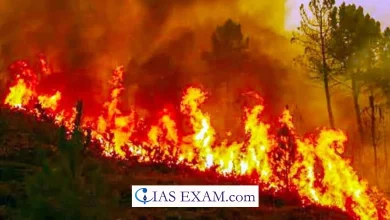Daily Current Affairs for UPSC
Concurrent heatwaves and rising sea levels threaten coastlines
Syllabus: Environment and Pollution[GS Paper-3]

Context
A concurrent heatwave and extreme sea level event, known as CHWESL, is when a heatwave and a sudden rise in sea level happen simultaneously in a coastal area. This can be very dangerous for communities living near the coast.
Details
- The threat of concurrent heatwaves and sea level rises to coastlines is a growing concern, as recent studies have shown.
- These simultaneous occurrences can have devastating effects on coastal communities, ecosystems, and infrastructure.
Key Findings from Recent Studies
- Increased Occurrences: An upsurge in the number of locations which experienced both prolonged heat waves and high short-term ocean level rises have been particularly veering toward the corridors of 1998 and 2017, compared to the pollution of the preceding age.
- Projected Frequency: The concurrent manner of these events is estimated to increase five times its previous probability, from the current 2025 to 2049 years.
- Global Impact: Countries with tropical climates are more likely to have higher frequency as well as more intensive such events than other coastal areas around the world, with some 88% of the coastlines experiencing those events over the period 1979 – 2017.
- Duration of Events: A mean of 3.72 days for the occurrence of these conditions is recorded on a yearly basis for 1998-2017 which is almost same as that of 1979-1998.
- Association with Heatwave Intensity: A chance of a further event exceeding 2% (approximately 2%) is about the same with the 1% increase in heat wave intensity (approximately 1%).
- Health Risks: The excess heat from heat waves poses serious health risks to coastal populations, which are compounded by the threat of flooding due to extreme sea levels.
Implications for Coastal Communities
- Infrastructure Damage: Problems with the coastal infrastructure rise with flooding and erosion that are connected with sea level rise and enhanced storm surges.
- Economic Losses: Local economies, especially those highly dependent on tourism and fishing, are faced with the challenges of hot tide high years and the sea level rise.
- Ecological Consequences: With just the sum of heat and flooding, ecosystems can be plagued with a suite of problems, incorporating habitat destruction and biodiversity loss.
- Displacement: The region inhabited by many people at risk which stands in close proximity to the coastline may become exposed to relocation.
- Health Concerns: Heat waves lead to surplus heat in coastal regions. As a result, they are at risk of experiencing health problems, which are intensified by the possibility of flooding caused by extreme sea levels. The coastal infrastructure including such things as houses, offices, and vital facilities might be prone to damages when they are exposed to flooding and erosion occasioned by these events.
Mitigation and Adaptation Strategies
- Early Warning Systems: Advanced early warning indicators of such happenings can be included predicting these occurring together and in due course prepared response and response can be ensured .
- Coastal Defences: Through the reinforcement of the coastal defences through, for example, seawalls and natural barriers, the sea level rise can be significantly mitigated.
- Urban Planning: Sustainable urban development where such a house is constructed or reconstruction of the houses in coastal communities is considered in the aspect of heat waves and sea level rise can thus reduce the vulnerability of such communities.
- Climate Action: To tackle the climate change issue, alleviate the increase of hurricanes and tornadoes, the impact of these phenomena should be reduced by cutting down on the amount of emissions.
Way Forward
- Governments, communities, and individuals must take immediate action to protect coastlines from the dual threats of heatwaves and rising sea levels.
- It is crucial to invest in research, infrastructure, and policies that will increase resilience to these climate challenges.
- The future of our coastlines and the people who rely on them depends on our ability to understand, predict, and adapt to these changing conditions.
- Global cooperation is essential in addressing these urgent issues, and the success of our actions will be seen in the health and stability of our coastlines, the safety of our communities, and the legacy we leave for future generations.
Source: The Hindu
UPSC Mains Practice Question
Q. Discuss the multifaceted impacts of concurrent heatwaves and rising sea levels on coastal regions. How can governments and communities effectively mitigate these threats while ensuring sustainable development and adaptation strategies?





.png)



